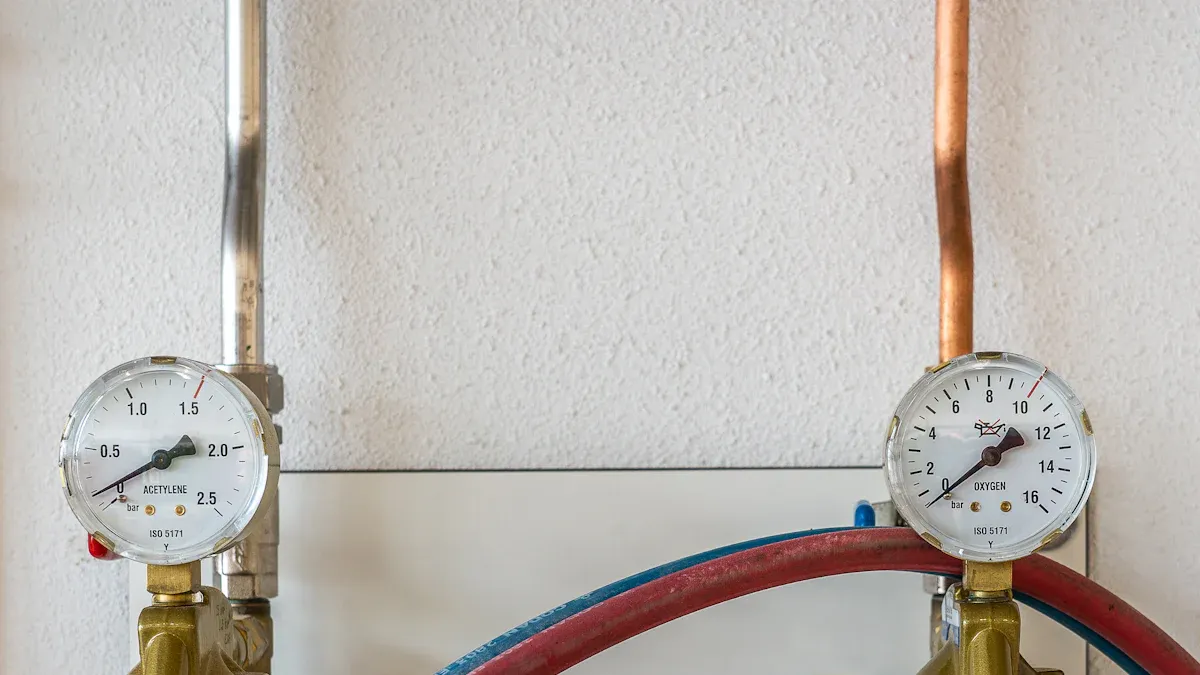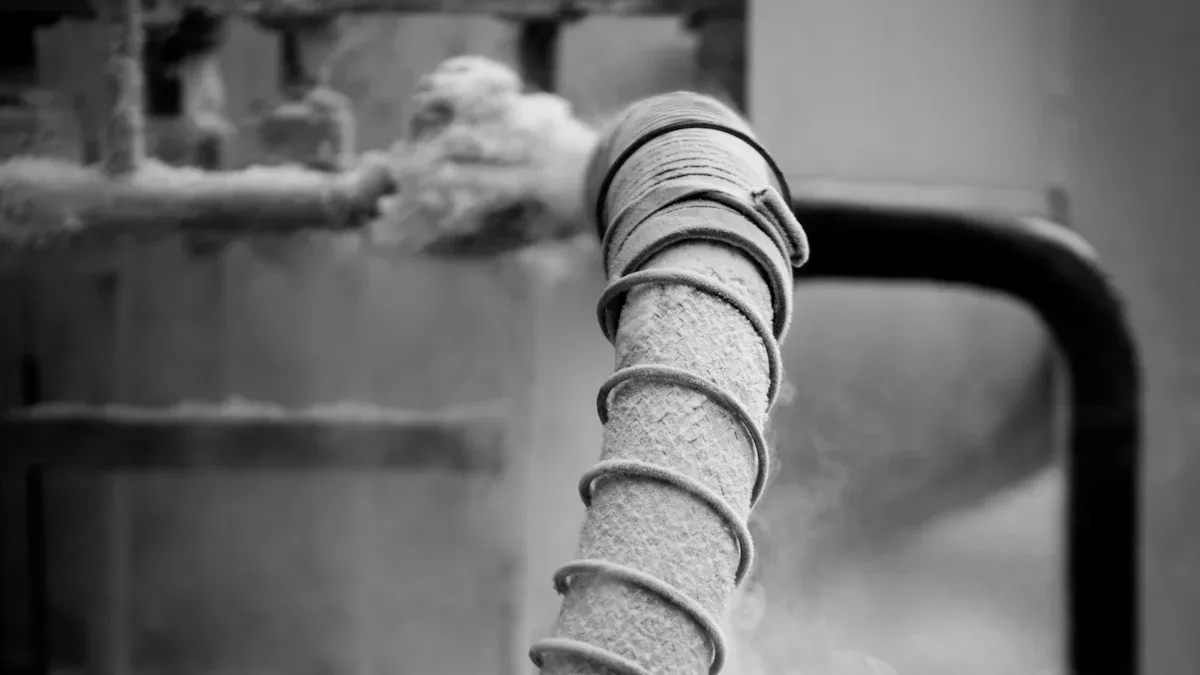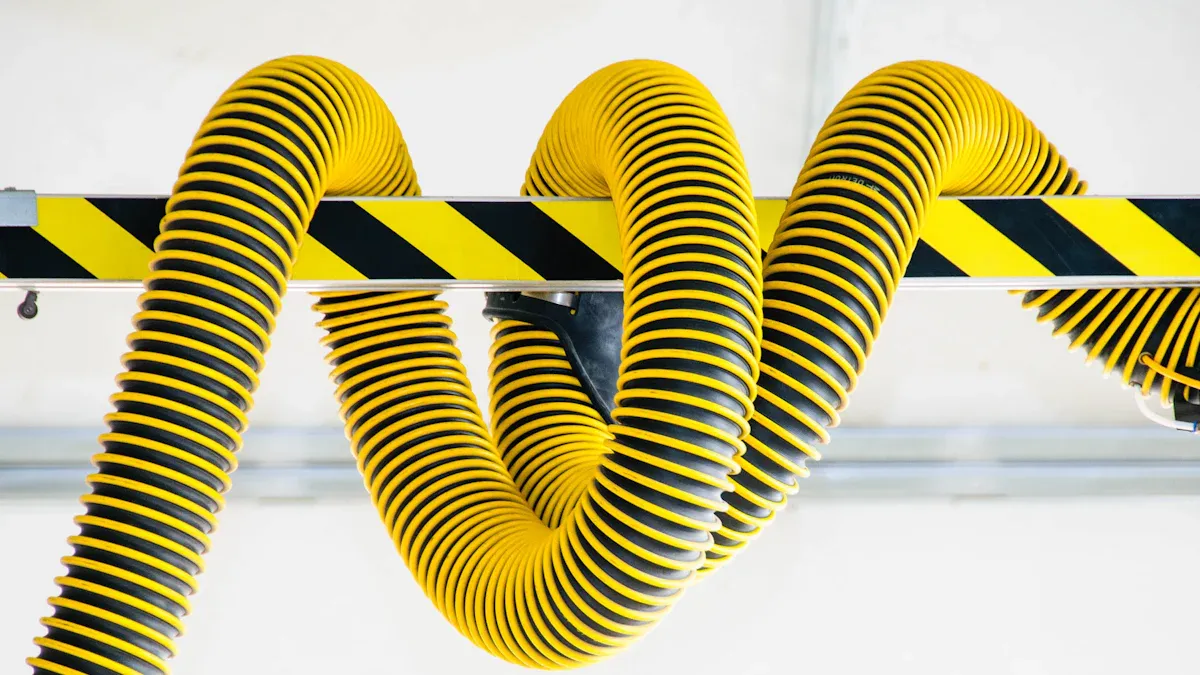
- Product quality, tested through burst and cyclic endurance, ensures hydraulic fittings withstand extreme pressures and repetitive stress.
- Material choice, such as stainless steel threaded pipe fittings or braided pipe fittings, adapts to harsh environments.
- Market trends show brands that innovate and support users offer greater value.
Best value means a hydraulic fitting delivers reliability, compatibility, and cost efficiency over its lifetime.
Key Takeaways
- Choose hydraulic fittings that pass strict quality and durability tests to ensure safety and long-lasting performance.
- Match fittings to your system’s pressure, fluid type, and environment to prevent leaks and failures.
- Consider total cost of ownership, including maintenance and energy costs, not just the initial price, for the best value.
Hydraulic Fitting Selection Criteria in 2025
Product Quality and Durability
Product quality and durability play a major role in selecting hydraulic fittings. Manufacturers use several tests to check if fittings can handle real-world conditions. These tests include:
- Tensile strength testing measures how much force a hose or fitting can take before it stretches or breaks.
- Abrasion resistance testing checks how well the material stands up to rubbing and scraping.
- Fatigue testing puts the fitting through many cycles of pressure to see if it cracks or leaks over time.
- Pressure testing increases the pressure to much higher than normal to make sure there are no leaks or bulges.
- Leak testing ensures that no fluid escapes, which keeps systems safe.
- Impulse testing simulates sudden pressure changes to see if the fitting stays strong.
Durability testing also exposes fittings to heat, cold, moisture, and mechanical stress. Temperature testing checks if fittings work in very hot or cold places. Electrostatic discharge testing makes sure fittings do not spark in dangerous environments. Quality control standards like ISO 9001 and SAE J517 help ensure that every fitting meets strict safety and quality rules.
Technical Specifications and Industry Standards
Technical specifications and industry standards help users pick the right hydraulic fitting for their system. Fittings come in different thread sizes and must meet certain standards to work safely. The table below shows common thread sizes and their uses:
| Thread Size (Metric) | Thread Size (Imperial) | Applicable Standard | Typical Application |
|---|---|---|---|
| M10x1.0 | 3/8-24 UNF | ISO 8434-1 / SAE J514 | Small hydraulic systems |
| M14x1.5 | 1/2-20 UNF | ISO 8434-1 / SAE J514 | Medium hydraulic systems |
| M18x1.5 | 3/4-16 UNF | ISO 8434-1 / SAE J514 | Medium-large systems |
| M22x1.5 | 7/8-14 UNF | ISO 8434-1 / SAE J514 | Large hydraulic systems |
| M27x2.0 | 1-1/16-12 UN | ISO 8434-1 / SAE J514 | Heavy-duty systems |
Manufacturers test fittings with proof pressure, burst pressure, and cyclic endurance tests. These tests make sure fittings can handle twice or even four times their rated pressure. Standards from groups like ISO, SAE, DIN, ASTM, and JIC help ensure fittings are safe and reliable in many industries.
System Compatibility and Integration
System compatibility means the hydraulic fitting must match the system’s pressure, fluid type, and installation needs. Compatibility test reports check if fittings meet pressure ratings, material needs, and sealing methods. These reports also confirm that fittings follow standards like SAE, ISO, NFPA, and PED. Integration studies show that fittings from different brands can work together without problems. Certification from groups like ISO 9001 gives extra confidence in the fitting’s safety and performance.
Tip: Always check that the fitting matches the system’s pressure and fluid type. This helps prevent leaks and failures.
Price and Total Cost of Ownership
Price matters, but the total cost of ownership gives a better picture of value. The table below breaks down the main costs over a fitting’s life:
| Cost Component | Description & Details |
|---|---|
| Initial Purchase Price | About 10% of total cost; includes equipment, installation, and testing. |
| Installation & Startup | Covers setup, training, and system checks. |
| Energy Consumption | Largest cost (about 40%); depends on system efficiency and hours of use. |
| Operations Labor | Includes monitoring and routine checks. |
| Maintenance & Repair | About 25% of total cost; covers regular upkeep, parts, and labor. |
| Downtime & Lost Production | High costs from unexpected failures; having spare parts can reduce these costs. |
| Environmental Costs | Includes handling leaks and disposing of hazardous materials. |
| Decommissioning & Disposal | Minor costs for removing and disposing of old parts. |
Maintenance statistics, like mean time between failure (MTBF), help predict how often parts might break. Most of the cost comes from energy and maintenance, not the initial price. Choosing a reliable fitting can lower these long-term costs.
Warranty and After-Sales Support
Warranty and after-sales support show how much a manufacturer trusts its product. Longer warranties mean the company believes the fitting will last. Good return and exchange policies help customers feel safe if something goes wrong. Fast and fair handling of returns or refunds builds trust and keeps customers happy. Even without exact numbers, these policies give a good idea of the support a buyer can expect.
Supplier Reputation and Reliability
Supplier reputation and reliability help buyers avoid problems. Reliable suppliers fill 99.6% of orders correctly and ship most orders within 24-48 hours. Many have strong supply chains with warehouses across the country, so products arrive quickly. Trusted suppliers offer quality certifications, like Material Test Reports and Certificates of Conformance. They keep enough stock to meet customer needs and offer discounts for large orders. Experienced technical staff can answer questions and solve problems. Many top suppliers have been in business for decades, showing they are stable and trustworthy.
Hydraulic Fitting Brand Comparison for 2025

Overview of Leading Brands: Parker Hannifin, Eaton, Gates, Manuli Hydraulics, Swagelok, RYCO, Cast S.p.A., Cangzhou QC Hydraulics, Yuyao Jiayuan
Many companies compete in the hydraulic fitting market in 2025. The top three brands by global market share are Parker Hannifin, Eaton, and Swagelok. Together, they hold about 18% of the worldwide market. China leads as the largest regional market with about 30% share. America follows with 27%. Other important brands include Manuli Hydraulics, Gates, RYCO, Cast S.p.A., Cangzhou QC Hydraulics, and Yuyao Jiayuan.
- Parker Hannifin, Eaton, and Swagelok lead the global market.
- Manuli Hydraulics, Gates, and RYCO are also well-known for their quality.
- Cast S.p.A., Cangzhou QC Hydraulics, and Yuyao Jiayuan have strong positions, especially in Asia.
- The market remains dynamic, with many companies investing in new technology and expanding their product lines.
Note: The growth of agricultural machinery and increased mechanization drive demand for hydraulic fittings in many regions.
Strengths and Weaknesses Comparison Table
The table below compares the strengths and weaknesses of leading hydraulic fitting brands. It covers pressure ratings, durability, application scenarios, and other key factors.
| Brand | Pressure Rating / Durability | Temperature Range | Application Scenarios | Strengths | Weaknesses |
|---|---|---|---|---|---|
| Parker Hannifin | Up to 5000 PSI; high durability | -40°F to 212°F | Construction, agriculture | Flexible design, robust support | Limited temperature range, abrasion risk |
| Gates | Meets 20+ international standards; durable | N/A | Industrial, automotive | Custom assemblies, broad standards | High cost, needs specific knowledge |
| Eaton | Extreme pressure and temperature ready | N/A | Construction, mining, aerospace | Sustainability focus, global distribution | Premium pricing, limited hose collection |
| Manuli Hydraulics | High-pressure, abrasion-resistant | Wide range | Oil & gas, mining, marine | Advanced materials, strong R&D | Less global reach than top three |
| Swagelok | Precision fittings, leak-tight performance | Wide range | Chemical, laboratory, instrumentation | High precision, excellent sealing | Higher price, niche focus |
| RYCO | Strong in mining and heavy industry | Wide range | Mining, construction, transport | Fast delivery, reliable supply | Smaller product range |
| Cast S.p.A. | Reliable, cost-effective | Standard range | General industry, OEM | Competitive pricing, good quality | Less innovation, limited global presence |
| Cangzhou QC Hydraulics | Stainless steel focus, corrosion-resistant | Standard range | Food, pharma, marine | Good for harsh environments | Smaller support network |
| Yuyao Jiayuan | Value-focused, wide selection | Standard range | General industry, Asia market | Affordable, large inventory | Lower brand recognition outside Asia |
Brand-Specific Highlights and Differentiators
Each hydraulic fitting brand brings unique strengths to the market. Parker Hannifin stands out for its flexible designs and high durability. The company has over a century of experience and focuses on solving engineering challenges through innovation. Gates invests heavily in research and development. Their products meet more than 20 international standards and perform well in extreme environments. Eaton emphasizes sustainability and energy efficiency. Their hydraulic fittings work under high pressure and temperature, making them suitable for demanding industries.
Manuli Hydraulics uses advanced materials and strong research to create fittings for oil, gas, and marine applications. Swagelok offers precision fittings with excellent sealing, making them a top choice for laboratories and chemical plants. RYCO delivers fast and reliable supply, especially for mining and heavy industry. Cast S.p.A. provides cost-effective solutions for general industry and original equipment manufacturers. Cangzhou QC Hydraulics specializes in stainless steel fittings that resist corrosion, ideal for food and marine uses. Yuyao Jiayuan focuses on value and offers a wide selection, serving the Asian market with affordable options.
Tip: When choosing a hydraulic fitting brand, match the brand’s strengths to your system’s needs. Consider pressure, temperature, and the type of environment.
Matching Hydraulic Fitting Brands to Your Application

Common Application Scenarios and Industry Needs
Different industries require hydraulic fittings that meet unique demands. Construction machinery often uses high-precision, durable fittings in excavators. These fittings allow real-time pressure monitoring, which improves safety and reduces maintenance costs. In oil and gas, companies select high-pressure, corrosion-resistant fittings for pipeline monitoring. These fittings help prevent leaks and explosions, while real-time data transmission supports quick system adjustments. Industrial equipment, such as hydraulic presses, relies on accurate pressure measurement fittings. These fittings support predictive maintenance and reduce downtime.
| Industry Sector | Application Scenario | Benefits and Outcomes |
|---|---|---|
| Construction Machinery | Durable fittings in excavator hydraulic systems | Real-time monitoring, improved safety, reduced maintenance costs |
| Oil and Gas | Corrosion-resistant fittings in high-pressure pipelines | Leak prevention, enhanced safety, timely system adjustments |
| Industrial Equipment | Pressure measurement fittings in hydraulic presses | Accurate monitoring, predictive maintenance, reduced failure rates |
Ensuring System Compatibility and Performance
Selecting the right hydraulic fitting ensures system compatibility and high performance. Laboratory tests check chemical exposure, tensile strength, and thermal stability. Field testing uses sensors and operator feedback to confirm performance in real conditions. Regular testing prevents failures and extends equipment life. Application-specific assessments look at pressure ratings, temperature ranges, and fluid types. These steps help match fittings to system needs and improve safety.
Tip: Use fittings that meet industry standards like SAE, ISO, and EN. These standards ensure proper pressure ratings, bend radius, and temperature tolerance.
Industry-Specific Considerations
Each industry faces unique challenges when choosing hydraulic fittings. Mechanical problems can result from thermal expansion, contamination, or bearing failure. Performance may drop if blockages or improper pressure settings occur. Preventive maintenance, such as scheduled inspections and fluid analysis, increases reliability. Some industries now use smart fittings with sensors for real-time monitoring. This technology helps reduce downtime and supports predictive maintenance. Regional needs also differ. Asia-Pacific focuses on industrial growth, North America values high-tech solutions, and Europe emphasizes eco-friendly standards. Compliance with standards like UL 2238, SAE J514, and ISO 6803 ensures safety and reliability across all sectors.
Practical Tips for Evaluating Hydraulic Fitting Value
Assessing Pros and Cons of Each Brand
Buyers should look at both the strengths and weaknesses of each brand before making a choice. Some brands offer advanced leak prevention and easier installation, which can lower maintenance costs. Others focus on quick-release couplings or smart hoses with sensors for real-time monitoring. These features help reduce downtime and improve efficiency. Cost-benefit analyses show that brands with strong research and development often provide better long-term value. Companies that use new technology and quality control, like AI defect detection, can deliver more reliable products. Sustainability and compatibility with bio-based fluids also add value for many users.
Interpreting Technical Data and Certifications
Understanding technical data and certifications helps buyers choose safe and reliable fittings. Many organizations set standards for hydraulic fittings, such as CSA, ASME, ASSE, IAPMO, and ISO. These groups define test methods, pressure ratings, and performance criteria. For example, CSA B64 covers vacuum breakers and backflow preventers, while ASSE 1013 sets rules for pressure backflow devices. SAE J517 and ISO standards focus on hose design and pressure ratings. Some manufacturers exceed these standards by offering hoses with tighter bend radii or higher pressure limits. Choosing fittings that meet or exceed these standards ensures safety and durability.
Evaluating Support, Warranties, and Service
Support and service play a big role in the value of a hydraulic fitting brand. Brands that offer longer warranties show confidence in their products. Good after-sales support includes fast response times, easy returns, and helpful technical advice. Reliable suppliers keep enough stock and deliver orders quickly. They also provide clear documentation and certifications. These services help reduce downtime and make maintenance easier for users.
Selecting the best value brand involves checking product quality, system compatibility, and long-term performance. Studies show that choosing the right seal materials and design reduces failures and downtime. Industry leaders track uptime, maintenance hours, and safety incidents to measure value. A quick checklist helps buyers compare brands and make informed decisions.
FAQ
What is the most important factor when choosing a hydraulic fitting brand?
Product quality stands as the top factor. High-quality fittings last longer and help prevent leaks or failures in hydraulic systems.
How can buyers check if a fitting meets industry standards?
Buyers should look for certifications like ISO, SAE, or DIN. These labels show that the fitting passed strict safety and performance tests.
Do all hydraulic fittings work with every type of fluid?
No. Some fittings only work with certain fluids. Always check the manufacturer’s guide to make sure the fitting matches the fluid in use.
Post time: Jun-24-2025
